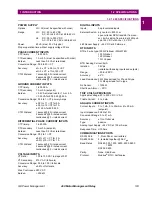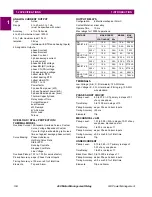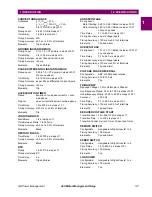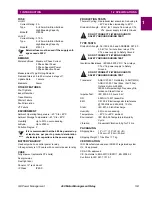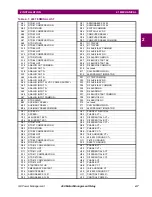
1-2
469 Motor Management Relay
GE Power Management
1.1 OVERVIEW
1 INTRODUCTION
1
Some of the protection highlights are detailed here; a complete list is shown below. Four assignable digital
inputs may be configured for a number of different features including tachometer or generic trip and alarm with
a programmable name. The thermal model incorporates unbalance biasing, RTD feedback, and exponential
cooling. In addition to the 15 standard overload curves, there is a custom curve feature and a curve specifically
designed for the starting of high inertia loads, when the acceleration time exceeds the safe stall time. A second
overload curve is provided for two-speed motors. Ground faults or earth leakage as low as 0.25 A may be
detected using the GE Power Management 50:0.025 Ground CT. CT inputs for phase differential protection are
also provided. The 12 RTD inputs provided may be individually field programmed for different RTD types. Volt-
age transformer inputs allow for numerous protection features based on voltage and power quantities. Four
4 to 20 mA analog inputs may be used for tripping and alarming on any transducer input such as vibration,
pressure, flow, etc.
Figure 1–2: PROTECTION FEATURES
51
Overload
86
Overload Lockout
66
Starts/Hour & Time Between Starts
Restart Block (Anti-Backspin Timer)
50
Short Circuit & Short Circuit Backup
Mechanical Jam
37
32
Undercurrent/Underpower
Reverse Power
46
Current Unbalance
50G/51G
Ground Fault & Ground Fault Backup
87
Differential
Acceleration
49
Stator RTD
38
Bearing RTD
Other RTD & Ambient RTD
Open RTD Alarm
Short/Low RTD
27/59
Undervoltage/Overvoltage
47
Phase Reversal
81
Frequency
Reactive Power
55/78
Power Factor
Analog Input
Demand Alarm: A kW kvar kVA
SR469 Self-Test, Service
Trip Coil Supervision
Welded Contactor
Breaker Failure
Remote Switch
14
Speed Switch & Tachometer Trip
Load Shed Switch
Pressure Switch
Vibration Switch
19
Reduced Voltage Start
48
Over Torque
Remote Start/Stop
PROCTLA5.CDR
Incomplete Sequence (Reduced Voltage Start)
Forced Relay Operation

















